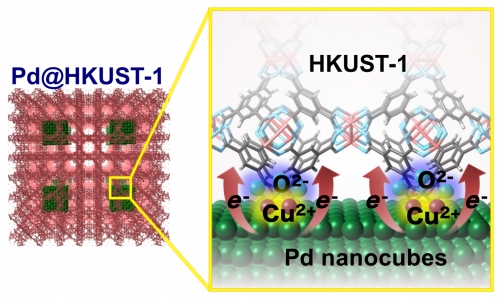研究成果 Research Results
- TOP
- News
- Research Results
- Interfacial Electronic State Improving Hydrogen Storage Capacity in Pd-MOF Materials
Interfacial Electronic State Improving Hydrogen Storage Capacity in Pd-MOF Materials
2018.11.29Research ResultsMaterials
—Discovery that the transfer of a charge equivalent to 0.4 electrons contributes to doubled hydrogen storage may expedite the development of new hybrid materials—
NIMS, Kyushu University and Kyoto University jointly identified a mechanism by which a hybrid material composed of palladium (Pd) and metal-organic frameworks (MOFs) is capable of storing approximately twice as much hydrogen as a material composed solely of Pd. The greater hydrogen storage capacity of the hybrid material is associated with a slight change in its elec-tronic state caused by the transfer of an electric charge—amounting to approximately 0.4 elec-trons—from the Pd to the MOFs. The joint research team therefore successfully determined the quantitative relationships between the materials’ electronic states and their hydrogen storage properties. These findings may facilitate the development of new hybrid materials with superior hydrogen storage properties or with the capability to efficiently catalyze hydrogenation reactions.
Hydrogen is a viable next-generation energy source. Widespread use of hydrogen will require efficient hydrogen storage methods. Transition metals, such as Pd, are known to possess ex-cellent hydrogen storage properties. Recent reports indicated that the hydrogen storage capa-bilities of materials composed of transition metal nanoparticles and MOFs are significantly higher than those of materials composed solely of a transition metal. It had been predicted that these increased hydrogen storage capabilities are associated with the transfer of electric charge at the interface between the transition metals and the MOFs. However, the mechanisms responsible for the increased hydrogen storage capabilities were not quantitatively understood (e.g., the amount of charge transferred).
They investigated the electronic state of a hybrid material, Pd@HKUST-1, which is composed of Pd nanocubes and MOFs (specifically, copper(II) 1, 3, 5-benzenetricarboxylate, or HKUST-1) and capable of storing approximately twice the amount of hydrogen of materials composed solely of Pd nanocubes. For this investigation, we used NIMS’s synchrotron X-ray beamline at SPring-8, the world’s largest synchrotron radiation facility. In addition, we calculated the elec-tronic states of Pd and HKUST-1 separately and compared them with the electronic state of Pd@HKUST-1. As a result, we found that an electric charge amounting to approximately 0.4 electrons had been transferred from the Pd nanocubes to the MOFs. This small charge transfer presumably enabled the electron bands in the Pd nanocubes to store more hydrogen, resulting in approximately doubled hydrogen storage capacity for the hybrid material compared to a material composed solely of Pd nanocubes.
Hybrid materials composed of transition metal nanoparticles and MOFs are potentially capable not only of storing large amounts of hydrogen but also of efficiently catalyzing hydrogenation reactions. The methods developed and used in this study to measure and analyze electronic states may accelerate the development of new hybrid materials with greatly increased hydrogen storage and catalytic capabilities.
This project was carried out by a research team led by Osami Sakata (Leader of the Synchrotron X-ray Group, Research Center for Advanced Measurement and Characterization, NIMS), Yanna Chen (Postdoctoral Researcher, NIMS), Michihisa Koyama (Professor, Inaromi Frontier Research Center, Kyushu University; currently a Unit Director, Center for Green Research on Energy and Environmental Materials, NIMS), Yusuke Nanba (Post-doctoral Fellow, Kyushu University; currently a Postdoctoral Researcher, NIMS), Hiroshi Kitagawa (Professor, Graduate School of Science, Kyoto University) and Hirokazu Kobayashi (Cooperative Associate Professor, Graduate School of Science, Kyoto University; also a JST PRESTO Researcher directing a “hyper-nano-space design” project supervised by Professor Kazuyuki Kuroda).
This study was supported by the MEXT Nanotechnology Platform Japan program and JST’s ACCEL project entitled “Creation of the functional materials on the basis of the inter-element-fusion strategy and their innovative applications” (grant number: JPMJAC1501, Research Director: Hiroshi Kitagawa, Pro-gram Manager: Akihiro Okabe).
This research was published in Communications Chemistry on October 9, 2018, GMT (on the same date Japan Time).

Figure:Charge transfer
(Left) Structure of a Pd@HKUST-1.
(Right) Schematic diagram illustrating the transfer of electric charge from a Pd nanocube to HKUST-1 MOFs (metal-organic frameworks)
Journal Reference
Electronic origin of hydrogen storage in MOF-covered palladium nanocubes investigated by synchrotron X-rays, , Communications Chemistry, 10.1038/s42004-018-0058-3Research-related inquiries
Michihisa Koyama, INAMORI Frontier Research Center, Kyushu University/Global Research Center for Environment and Energy based on Nanomaterials Science, National Institute for Materials Science
Link to National Institute for Materials Science(NIMS)
Link to National Institute for Materials Science(NIMS)
- TOP
- News
- Research Results
- Interfacial Electronic State Improving Hydrogen Storage Capacity in Pd-MOF Materials































